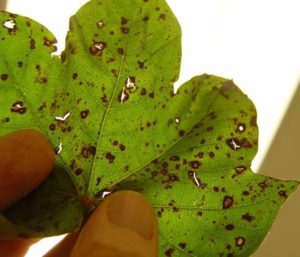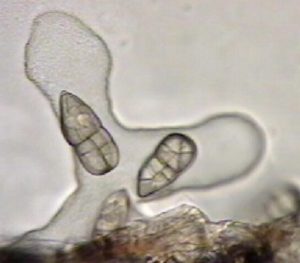Caused by: Stemphylium solani
Foliar Symptoms: Stemphylium Leaf Spot lesions are 2 cm in diameter (~1 inch), circular in shape and brown in color with concentric zones. As they mature the lesions will have a whitish center that may crack and fall out producing a “shot-hole” appearance. The lesions normally form on the upper leaves in the canopy and start at the leaf margin and move inward. Fields where Stemphylium Leaf Spot is severe also typically demonstrate symptoms of nutrient deficiency.
Diagnostic Note: Stemphylium Leaf Spot can be differentiated from Target Spot by position on the plant (Stemphylium typically is found at the top of the plant first, Target Spot is within the canopy). Also, leaves affected by Stemphylium Leaf Spot often show nutrient deficiencies (yellow and red) while leaves affected by Target Spot often appear green, unless approaching senescence.
Range and Yield Loss: Stemphylium Leaf Spot has been found in all the cotton producing areas of the U.S. Since this disease is normally associated with other plant stress factors (drought, nutrient deficiencies, nematode and insect pressure) yield loss can be severe from the stress complex.
Managing vigorous crop growth by irrigating to avoid drought stress, proper fertilization, and reducing pest pressure will help reduce the incidence of disease outbreaks. Fungicides are available but are not normally economical for the control of Stempyhlium Leaf Spot.


